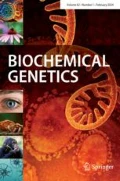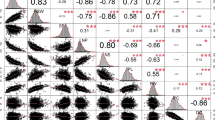Abstract
Polyploid Prunus spinosa (2n = 4×) and P. insititia (2n = 6×) represent enormous genetic potential in Central Europe, which can be exploited in breeding programmes. In Hungary, 17 cultivar candidates were selected from wild-growing populations including 10 P. spinosa, 4 P. insititia and three P. spinosa × P. domestica hybrids (2n = 5×). Their taxonomic classification was based on their phenotypic characteristics. Six simple sequence repeats (SSRs) and the multiallelic S-locus genotyping were used to characterize genetic variability and reliable identification of the tested accessions. A total of 98 SSR alleles were identified, which presents 19.5 average allele number per locus, and each of the 17 genotypes could be discriminated based on unique SSR fingerprints. A total of 23 S-RNase alleles were identified. The complete and partial S-genotype was determined for 8 and 9 accessions, respectively. The identification of a cross-incompatible pair of cultivar candidates and several semi-compatible combinations help maximize fruit set in commercial orchards. Our results indicate that the S-allele pools of wild-growing P. spinosa and P. insititia are overlapping in Hungary. A phylogenetic and principal component analysis confirmed the high level of diversity and genetic differentiation present within the analysed genotypes and helped clarify doubtful taxonomic identities. Our data confirm that S-locus genotyping is suitable for diversity studies in polyploid Prunus species. The analysed accessions represent huge genetic potential that can be exploited in commercial cultivation.



Similar content being viewed by others
Change history
23 June 2021
A Correction to this paper has been published: https://doi.org/10.1007/s10528-021-10091-6
References
Ainouche ML, Wendel JF (2014) Polyploid speciation and genome evolution: Lessons from recent allopolyploids. In: Pontarotti P (ed) Evolutionary biology: genome evolution, speciation, coevolution and origin of life. Springer International Publishing, Berlin, pp 87–113
Chin SW, Shaw J, Haberle R, Wen J, Potter D (2014) Diversification of almonds, peaches, plums and cherries–molecular systematics and biogeographic history of Prunus (Rosaceae). Mol Phylogenet Evol 76:34–48
Crane MB, Lawrence WJC (1952) The genetics of garden plants, 4th edn. Macmillan, London
Dirlewanger E, Cosson P, Tavaud M, Aranzana M, Poizat C, Zanetto A, Arús P, Laigret F (2002) Development of microsatellite markers in peach [Prunus persica (L.) Batsch] and their use in genetic diversity analysis in peach and sweet cherry (Prunus avium L.). Theor Appl Genet 105:127–138
Erturk Y, Ercisli S, Maghradze D, Orhan E, Agar G (2009) An assessment of genetic variability and relationships among wild-grown blackthorn (Prunus spinosa L.) plants based on RAPD markers. Genet Mol Res 8:1238–1244
Erturk Y, Ercisli S, Tosun M (2012) Physico-chemical characteristics of wild plum fruits (Prunus spinosa L.). Int J Plant Prod 3:89–92
Eryomine GV (1990) New data on origin of Prunus domestica L. Acta Hortic 283:27–30
Galli ZS, Halász G, Kiss E, Heszky L, Dobránszki J (2005) Molecular identification of commercial apple cultivars with microsatellite markers. HortScience 40:1974–1977
Guitian J, Guitian P, Sanchez JM (1993) Reproductive biology of 2 Prunus species (Rosaceae) in the Northwest Iberian Peninsula. Plant Syst Evol 185:153–165
Halász J, Hegedűs A, György Z, Pállinger É, Tóth M (2011) S-genotyping of old apple cultivars from the Carpathian basin: methodological, breeding and evolutionary aspects. Tree Genet Genomes 7:1135–1145
Halliday G, Beadle M (1983) Flora Europaea. Cambridge University Press, Cambridge
Hammer Ř, Harper DAT, Ryan PD (2001) PAST: paleontological statistics software package for education and data analysis. Palaeontol Electron 4:1–9
Hegedűs A, Lénárt J, Halász J (2012) Review of sexual incompatibility in tree fruit species: molecular interactions and evolutionary dynamics. Biol Plantarum 56:201–209
Horvath A, Balsemin E, Barbot JC, Christmann H, Manzano G, Reynet P, Laigret F, Mariette S (2011) Phenotypic variability and genetic structure in plum (Prunus domestica L.), cherry plum (P. cerasifera Ehrh.) and sloe (P. spinosa L.). Sci Hortic-Amsterdam 129:283–293
Kodad O, Alonso JM, i Martí AF, Oliveira MM, Socias i Company R (2010) Molecular and physiological identification of new S-alleles associated with self-(in) compatibility in local Spanish almond cultivars. Sci Hortic-Amsterdam 23:308–311
Kodad O, Hegedűs A, Halász J (2013) Self-(in) compatibility genotypes of Moroccan apricots indicate differences and similarities in the crop history of European and North African apricot germplasm. BMC Plant Biol 13:1
Kota-Dombrovska I, Lācis G (2013) Evaluation of self-incompatibility locus diversity of domestic plum (Prunus domestica L.) using DNA-based S-genotyping. Proc Latv Acad Sci B. 67:109–115
Kovács SZ (2015) Vadgyümölcsök a kertben és ültetvényekben. Cser Kiadó, Budapest
Mnejja M, Garcia J, Howad W, Badenes ML, Arús P (2004) Simple-sequence repeat (SSR) markers of Japanese plum (Prunus salicina Lindl.) are highly polymorphic and transferable to peach and almond. Mol Ecol Notes 4:163–166
Mnejja M, Garcias J, Howad W, Arús P (2005) Development and transportability across Prunus species of 42 polymorphic almond microsatellites. Mol Eco Notes 5:531–535
Mohanty A, Martin JP, Aguinagalde I (2000) Chloroplast DNA diversity within and among populations of the allotetraploid Prunus spinosa L. Theor Appl Gen 100:1304–1310
Nielsen J, Olrik DC (2001) A morphometric analysis of Prunus spinosa, P. domestica ssp. insititia, and their putative hybrids in Denmark. Nord J Bot 21:349–363
Nunes MD, Santos RA, Ferreira SM, Vieira J, Vieira CP (2006) Variability patterns and positively selected sites at the gametophytic self-incompatibility pollen SFB gene in a wild self-incompatible Prunus spinosa (Rosaceae) population. New Phytol 172:577–587
Ortega E, Sutherland BG, Dicenta F, Boskovic R, Tobutt KR (2005) Determination of incompatibility genotypes in almond using first and second intron consensus primers: detection of new S alleles and correction of reported S genotypes. Plant Breed 124:188–196
Potter D, Eriksson T, Evans RC, Oh S, Smedmark JEE, Morgan DR, Kerr M, Robertson KR, Arsenault M, Dickinson TA, Campbell CS (2007) Phylogeny and classification of Rosaceae. Plant Syst Evol 266:5–43
Reales A, Sargent DJ, Tobutt KR, Rivera D (2010) Phylogenetics of Eurasian plums, Prunus L. section Prunus (Rosaceae), according to coding and non-coding chloroplast DNA sequences. Tree Genet Genomes 6:37–45
Reynders-Aloisi S, Grellet F (1994) Characterization of the ribosomal DNA units in two related Prunus species (P. cerasifera and P. spinosa). Plant Cell Rep 13:641–646
Ruiz-Rodríguez BM, de Ancos B, Sánchez-Moreno C, Fernández-Ruiz V, de Cortes Sánchez-Mata M, Cámara M, Tardío J (2014) Wild blackthorn (Prunus spinosa L.) and hawthorn (Crataegus monogyna Jacq.) fruits as valuable sources of antioxidants. Fruits 69:61–73
Sipos B, Szabó T (2004) Fruit species with special value (in Hungarian). In: Kodáry E (ed) Fruit crops of the Carpathian Basin. Zászlónk Stúdió, Budapest
Sonneveld T, Robbins TP, Bošković R, Tobutt KR (2001) Cloning of six cherry self-incompatibility alleles and development of allele-specific PCR detection. Theor Appl Genet 102:1046–1055
Sonneveld T, Tobutt KR, Robbins TP (2003) Allele-specific PCR detection of sweet cherry self-incompatibility (S) alleles S 1 to S 16 using consensus and allele-specific primers. Theor Appl Genet 107:1059–1070
Sutherland BG, Robbins TP, Tobutt KR (2004) Primers amplifying a range of Prunus S-alleles. Plant Breed 123:582–584
Vander Mijnsbrugge K, Depypere L, Chaerle P, Goetghebeur P, Breyne P (2013) Genetic and morphological variability among autochthonous Prunus spinosa populations in Flanders (northern part of Belgium): implications for seed sourcing. Plant Ecol Evol 146:193–202
Vieira J, Santos RAM, Ferreira SM, Vieira CP (2008) Inferences on the number and frequency of S-pollen gene (SFB) specificities in the polyploid Prunus spinosa. Heredity 101:351–358
Walsh PS, Erlich HA, Higuchi R (1992) Preferential PCR amplification of alleles: mechanisms and solutions. Genome Res 1:241–250
Yamane H, Tao R (2009) Molecular basis of self-(in)compatibility and current status of S-genotyping in Rosaceous fruit trees. J Jap Soc Hort Sci 78:137–157
Yilmaz KU, Ercisli S, Asma BM, Dogan Y, Kafkas S (2009) Genetic relatedness in Prunus genus revealed by inter-simple sequence repeat markers. HortScience 44:293–297
Zimmer J (2011) Die Schlehe (Prunus spinosa). DLR Rheinpfalz-Kompetenzzentrum Gartenbau, Rheinbach
Acknowledgments
This work was funded by the National Research, Development and Innovation Office (OTKA) K 112554 project. J. Halász is grateful for receiving the János Bolyai Research Scholarship of the Hungarian Academy of Sciences.
Author information
Authors and Affiliations
Corresponding author
About this article
Cite this article
Halász, J., Makovics-Zsohár, N., Szőke, F. et al. RETRACTED ARTICLE: Simple Sequence Repeat and S-locus Genotyping to Explore Genetic Variability in Polyploid Prunus spinosa and P. insititia. Biochem Genet 55, 22–33 (2017). https://doi.org/10.1007/s10528-016-9768-3
Received:
Accepted:
Published:
Issue Date:
DOI: https://doi.org/10.1007/s10528-016-9768-3




